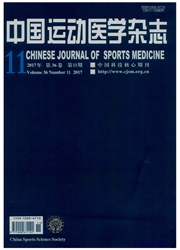

 中文摘要:
中文摘要:
目的:比较外周血(peripheralblood PB)与骨髓(bonemarrow,BM)来源MSC复合脱钙皮质骨基质(demineralizedcorticalbonematrix,DCBM)修复兔膝关节软骨缺损的效果。为其进一步的临床应用提供实验参考。方法:获取分离培养的第三代兔PB—MSC和BM—MSC,以2x107/ml的细胞密度接种于DCBM上。20只成年新西兰兔,构建股骨远端滑车关节面中心部大面积全层软骨缺损模型,随机分为4组:I组:PB—MSC/DCBM复合物;II组:BM—MSC/DCBM复合物;III组:单纯DCBM支架组;IV组:空白缺损组。分别于术后24周、48周取材,通过大体观察、组织学评分、组织化学和免疫组织化学染色评价其在体内修复软骨的效果。结果:移植后24周PB—MSC/DCBM组:修复区由半透明组织填充,局部有小的浅的凹陷,表面光整,稍低于周围正常软骨,与周围组织连接连续。BM—MSC/DCBM组的大体观察类似I组。单纯DCBM组:表面光整,与周围组织连续性不如I、II组。空白缺损组:仍有一大的缺损。48周PB—MSC/DCBM组和BM—MSC/DCBM组,缺损区基本不可见,充填好,表面光滑,基本和周围正常组织无界限.与周围软骨连续性好,软骨细胞外基质表达较多。组织学评分显示:在24周和48周两个时间点.PB—MSC/DCBM组和BM—MSC/DCBM组比较组间无差异,均显著高于单纯DCBM组和空白缺损组。结论:PB—MSC具备与BM—MSC相似的修复兔关节软骨缺损的能力。
 英文摘要:
英文摘要:
Objective To compare the results of applying peripheral blood (PB) derived mesenchymal stem cell (MSC) and bone marrow (BM) derived MSC combined with allogenic decalcified cortical bone matrix (DCBM) in treating articular cartilage defect in rabbits. Methods The third passage of cultured PB-MSC in vitro and BM-MSC were seeded in DCBM scaffolds with a density of 2×10^7/ml. Twenty adult New Zealand rabbits with trochlear articular cartilage defects in the distal femur were artificialy created, and then randomly divided into four groups:group repaired with PB-MSC/ DCBM complex (group I), group repaired with BM-MSC/DCBM complex (group II), group repaired with DCBM (group III), and defects control group without repair (group IV). Samples were observed at 24th week and 48th week after repair and evaluated in gross appearance, histological scoring, histochemical and immunohistochemical staining. Results There were overflwed semitransparent tissues, with smooth surface and good continuity with the sun'ounding cartilage at 24th week after repair in group I. The results in group II were similar to those in gronp I. In group III, the surface of the cartilage defect was smooth but not so well incorporated with the surrounding normal cartilage as in group I and II. A large cartilage defect sustained in the group IV. At 48th week after repair, the margins of the reparative tissues in group I and II were not distinguishable from the surrounding normal cartilage. They incorporated well with the normal cartilage, with substantial expression of ehondrocyte extracellular matrix. Histological scoring results showed that there was no significant difference between group I and group II at 24th or 48th week after repair. Conclusion PB-MSC has the similar capacity for articular cartilage repair as BM-MSC in rabbits.
 同期刊论文项目
同期刊论文项目
 同项目期刊论文
同项目期刊论文
 期刊信息
期刊信息
